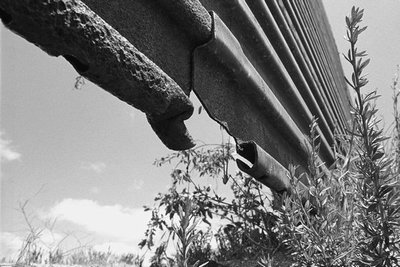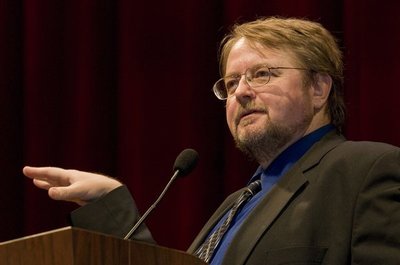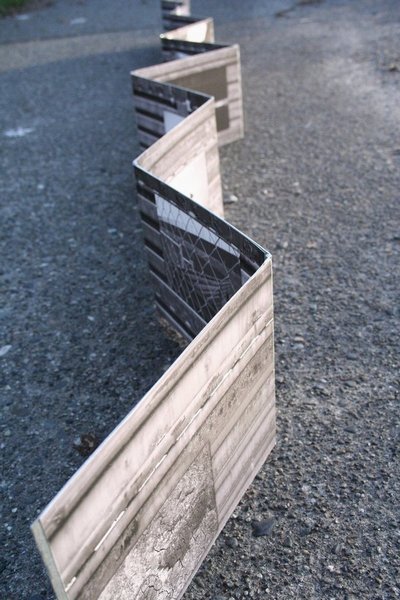October 30, 2008
Common Book event and photo exhibit bring border to life
This year’s Common Book, The Devil’s Highway, brings U.S.-Mexican border issues to the forefront of readers’ minds as it tells the true story of a horrifying journey that claimed the lives of 14 Mexican immigrants along an aptly named stretch of Arizona desert.
To complement the Common Book’s theme, UW alumna Kyla Lackie has brought a visual account of the border to Odegaard Undergraduate Library in a photo exhibit that displays the stark reality of what is, for some people, an abstract concept.
“I don’t think many people have the opportunity to see what the border actually looks like,” Lackie said. “My goal was to have people at the UW … interact with the border through the images. It can be easy, far away from the border, to not think about it, but it is an issue we need to be thinking and talking about.”
Author Luis Alberto Urrea had similar hopes for the impact of The Devil’s Highway, as he told a crowd of freshman and other Common Book readers at Meany Hall Oct. 22.
“I just felt that it was really interesting to try to reveal as many secrets as I could learn about the border, that I didn’t know, to tell you,” he said. “Because I figured … once I’ve put the information that I could glean in your hands, maybe you, as you go forth and change the world, can use it somehow.”
Lackie’s photographs are the results of hundreds of visits to the border over the four years she attended the University of San Diego as an undergraduate. She photographed the border’s dividing wall and surrounding environment to capture the physical and metaphorical divide it creates between the U.S. and Mexico. She also got a sense of what migrants might see and feel when they cross, beginning a journey that can often end in tragedy.
Although U.S. border patrol agents warned Lackie to be careful as she explored the border, she said she had a unique feeling whenever she travelled to the border — she was unusually nervous rather than frightened.
“I don’t know what it was — I guess just being alone in such a place that has so much charged energy,” she explained. Lackie sometimes brought a friend with her to the border at first, but her photography professor at USD noticed a difference between the photos she took with a friend and the ones she took alone.
“He would say, ‘Your photographs aren’t as good [when you’re with someone] because you aren’t able to convey how you’re feeling — that nervousness, on high alert — how a migrant would feel,'” Lackie said. “[Being alone] made the work more real and made me engage more with the situation.”
The Devil’s Highway similarly puts readers into migrants’ shoes, describing the true story of 24 crossers in excruciating detail. Only 12 men survived the trip — and just barely. Urrea describes every step of their suffering, helping readers realize the enormity of what migrants risk when they come to the U.S.
Urrea said the U.S. Border Patrol Academy now teaches the book, and older agents make younger agents read it for the same reason: “They want those guys to understand what the motivation is that brings people here,” he said.
Urrea’s initial goal for the book was simple: he wanted people to care about border and immigration issues, and specifically about the migrants who have died crossing the border.
“I feel that there is a lot of agitation, there is a lot of propaganda, there is a lot of hot air flying around, but I don’t know that people in this country are given enough information about the situation,” he said. “…I think I came out of [writing the book] really, really itching for substantive, measurable reform — action.”
Lackie was also inspired to take action on border issues. She said her early visits to the border made her feel frustrated, confused and angry after hearing personal stories about the impact of the border and U.S. immigration policies. She took part in protests and worked with border activism groups, and wants to challenge the UW community to get involved with border issues — even though the border itself is far away.
“[I want] UW students to engage the privilege and access they have through their education,” Lackie said, “to really consider the impact they can have on the community and the issues that need attention — critical social justice issues like immigration.”
Lackie, who has a master’s degree in public administration from the Evans School, had the chance to meet Urrea, who saw her photo exhibit while on a tour of campus.
“It was exciting to meet another person who is so engaged in border issues and has made such a big impact on people,” she said. “He really liked my work and recommended I get in touch with another photographer who is also doing work with border issues and photographing the immigrant experience.”
Lackie’s photos will be on display in Odegaard through December. She said she is grateful for the opportunity to share her experiences of the border with the UW community.
“It’s exciting to have the issues be raised in Seattle and be a part of that conversation.”
Kyla Lackie invites comments about her border photography exhibit — contact her at borderphotography@gmail.com.
University Libraries is offering additional opportunities to discuss the UW Common Book. Open to all students, faculty, and staff.
- Tue, Nov 4, 2:00-3:00 p.m., Allen Library Petersen Room (4th Floor)
- Thu, Nov 6, 3:30-4:30 p.m., Allen Library Petersen Room (4th Floor)
Please RSVP is you would like to attend: https://catalysttools.washington.edu/webq/survey/lisanne/62918.
Can’t make it, but still want to discuss The Devil’s Highway? Contact Heather Stapelman at zmaya@u.washington.edu to request additional sessions.
For more information about the UW Common Book, visit online at http://www.washington.edu/uaa/commonbook/.



